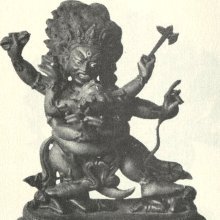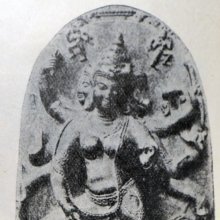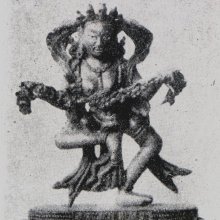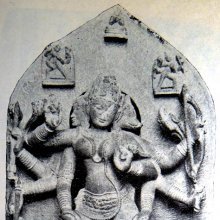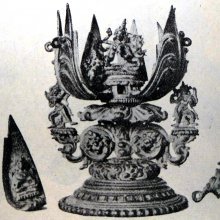Vajrankusha, Vajrāṅkuśa, Vajrāṅkuśā, Vajrāṃkuśa, Vajrāṃkuśā, Vajramkusha: 6 definitions
Introduction:
Vajrankusha means something in Buddhism, Pali, Jainism, Prakrit, Hinduism, Sanskrit. If you want to know the exact meaning, history, etymology or English translation of this term then check out the descriptions on this page. Add your comment or reference to a book if you want to contribute to this summary article.
The Sanskrit terms Vajrāṅkuśa and Vajrāṅkuśā and Vajrāṃkuśa and Vajrāṃkuśā can be transliterated into English as Vajrankusa or Vajrankusha or Vajramkusa or Vajramkusha, using the IAST transliteration scheme (?).
Images (photo gallery)
(+4 more images available)
In Buddhism
Tibetan Buddhism (Vajrayana or tantric Buddhism)
Source: Wisdom Library: MañjuśrīnāmasaṃgītiVajrāṅkuśa (वज्राङ्कुश) is one of the four door guardians appearing in the Vajradhātu-mahāmaṇḍala, according to the Nāmamantrārthāvalokinī v5.37. The Nāmamantrārthāvalokinī (literally, ‘an explanation of the nāma-mantras’) is a commentary (ṭīkā) on the 8th century Mañjuśrīnāmasaṃgīti.
Vajrāṅkuśa is a name of Mañjuśrī (the embodiement of non-dual knowledge) and, together with other names, forms the core essence of the Mañjuśrīnāmasaṃgīti. The Nāmamantrārthāvalokinī provides the practitioner a sādhana (‘meditative practice’) to turn these names into mantras. These mantras are chanted for the benefit of all beings, and then placed and contemplated in the Vajradhātu-mahāmaṇḍala, which is an extended version of the Vajradhātu-maṇḍala.
Source: Google Books: An Illustrated History of the MandalaVajrāṅkuśa (वज्राङ्कुश) refers to one of the four gatekeepers of the Vajradhātumaṇḍala and corresponds to Rūpavajra of the seventeen-deity maṇḍala, according to the Prajñāpāramitānayasūtra: an ancient Buddhist Tantric text recited daily in the Japanese Shingon sect which is closely related to the Sarvatathāgatatattvasaṃgraha.—The seventeen-deity maṇḍala, representing the deification of the seventeen viśuddhipadas, corresponds to the great maṇḍala described in the Mahāsamayatattvavajra, which explains seventeen viśuddhipadas (twenty in the Chinese translation). [...] Iconographically, the four Bodhisattvas arranged in the four gates of the outer maṇḍala correspond to the four gatekeepers of the Vajradhātumaṇḍala—i.e., Rūpavajra corresponds to Vajrāṅkuśa.
Source: OSU Press: Cakrasamvara SamadhiVajrāṅkuśa (वज्राङ्कुश) refers to the “vajra-hook” [i.e., oṃ vajrāṅkuśa jaḥ], according to the Guru Mandala Worship (maṇḍalārcana) ritual often performed in combination with the Cakrasaṃvara Samādhi, which refers to the primary pūjā and sādhanā practice of Newah Mahāyāna-Vajrayāna Buddhists in Nepal.

Tibetan Buddhism includes schools such as Nyingma, Kadampa, Kagyu and Gelug. Their primary canon of literature is divided in two broad categories: The Kangyur, which consists of Buddha’s words, and the Tengyur, which includes commentaries from various sources. Esotericism and tantra techniques (vajrayāna) are collected indepently.
In Jainism
General definition (in Jainism)
Source: archive.org: The Jaina IconographyVajrāṅkuśā (वज्राङ्कुशा) refers to one of the sixteen Vidyādevīs (goddesses of learning), commonly depicted as in Jaina iconography.—Vajrāṃkuśā, too, has two forms according to Śvetāmbara texts. In one, she rides an elephant and bears as symbols a sword, vajra, shield and spear. In another, she is riding an elephant in Varada-mudrā, Vajra, citrus and goad. The Digambaras represent the deity as driving in an aerial car and holding in her hands a goad and a lute. The Vidyādevī of the present description bears the same name as the Śvetāmbara Yakṣiṇī of Anantanātha. Some symbols of the Śvetāmbara form and others of the Digambara form, such as sword, spear and goad come to be equal to those of the Yakṣiṇī. The symbol of an elephant, the name Vajrāṃkuśā meaning “one adorned with vajra and goad” leads us to suppose some mysterious connection between this Vidyādevī and Indra. Her Iute, as given by the Digambaras, is only a symbol of Sarasvatī.

Jainism is an Indian religion of Dharma whose doctrine revolves around harmlessness (ahimsa) towards every living being. The two major branches (Digambara and Svetambara) of Jainism stimulate self-control (or, shramana, ‘self-reliance’) and spiritual development through a path of peace for the soul to progess to the ultimate goal.
Languages of India and abroad
Sanskrit dictionary
Source: Cologne Digital Sanskrit Dictionaries: Edgerton Buddhist Hybrid Sanskrit DictionaryVajrāṅkuśa (वज्राङ्कुश).—m., name of a mountain: Kāraṇḍavvūha 72.1, 3.
Source: Cologne Digital Sanskrit Dictionaries: Monier-Williams Sanskrit-English DictionaryVajrāṅkuśa (वज्राङ्कुश):—[from vajra > vaj] m. Name of a mountain, [Kāraṇḍa-vyūha]
Sanskrit, also spelled संस्कृतम् (saṃskṛtam), is an ancient language of India commonly seen as the grandmother of the Indo-European language family (even English!). Closely allied with Prakrit and Pali, Sanskrit is more exhaustive in both grammar and terms and has the most extensive collection of literature in the world, greatly surpassing its sister-languages Greek and Latin.
See also (Relevant definitions)
Partial matches: Ankusha, Vajra.
Full-text: Vajrankushi, Ankushamudra, Rupavajra, Sucihasta, Varttali, Vidyadevi, Vishuddhipada, Ubhayavarahanana, Vajratara, Maricipicuva.
Relevant text
Search found 5 books and stories containing Vajrankusha, Vajra-aṃkuśā, Vajra-aṃkuśa, Vajra-amkusa, Vajra-aṅkuśa, Vajra-aṅkuśā, Vajra-ankusa, Vajrāṃkuśa, Vajrāṃkuśā, Vajramkusa, Vajramkusha, Vajrāṅkuśa, Vajrāṅkuśā, Vajrankusa; (plurals include: Vajrankushas, aṃkuśās, aṃkuśas, amkusas, aṅkuśas, aṅkuśās, ankusas, Vajrāṃkuśas, Vajrāṃkuśās, Vajramkusas, Vajramkushas, Vajrāṅkuśas, Vajrāṅkuśās, Vajrankusas). You can also click to the full overview containing English textual excerpts. Below are direct links for the most relevant articles:
Chaitanya Bhagavata (by Bhumipati Dāsa)
Verse 1.1.98 < [Chapter 1 - Summary of Lord Gaura’s Pastimes]
Verse 1.5.1 < [Chapter 5 - Eating the Mendicant Brāhmaṇa’s Offerings]
Bhakti-rasamrta-sindhu (by Śrīla Rūpa Gosvāmī)
Verse 2.1.52 < [Part 1 - Ecstatic Excitants (vibhāva)]
The Indian Buddhist Iconography (by Benoytosh Bhattachacharyya)
Figure 152-155 - Emanations of Vairocana: Aṣṭabhuja and Daśabhujasita Mārīcī
Figure 180-183 - Emanations of Ratnasambhava: Vajratārā and Puṣpatārā
Saraswati < [Aug - Sept 1939]
A Dictionary Of Chinese Buddhist Terms (by William Edward Soothill)
